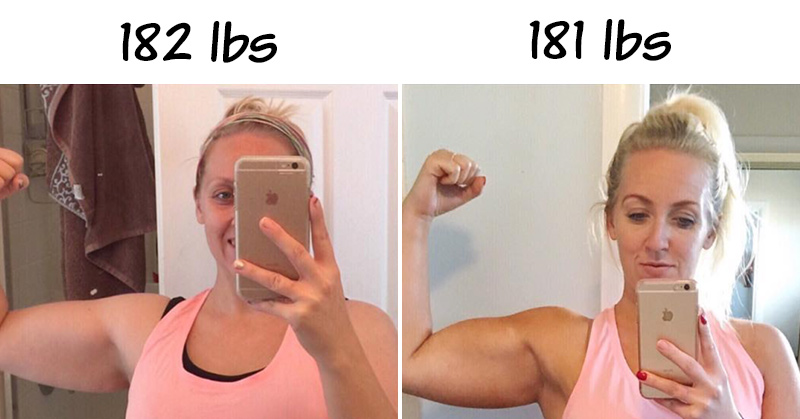Every day, thousands of people flock to the gym to trudge grudgingly on a treadmill or other cardio machine for a predetermined amount of time. When we’ve become sufficiently sweaty, we head to the bathroom scale and hold our breath — willing the tiny needle to stop going up, up, up.
Despite our hours at the gym and time spent wishing the salad in front of us was a big, juicy burger, the number on the scale doesn’t budge, or even if it does, we still don’t like the way we look. We become discouraged, give up, gain weight back, and are even unhappier than before, and thus the cycle of unhappiness continues. Does this cycle sound familiar to you?
This fixation on a number is unhelpful and unhealthy. We’ve reduced our self-worth to whatever we weigh, convinced that once we lose that ten pounds or reach that goal weight, we’ll be happy. 31-year-old mother of four, Adrienne Osuna, used to share this mindset — until she discovered the benefits of strength training.
Read More: Fat Vs Bloated – Have You Gained Weight Or Are You Bloated?
Adrienne’s Journey to Weight Loss
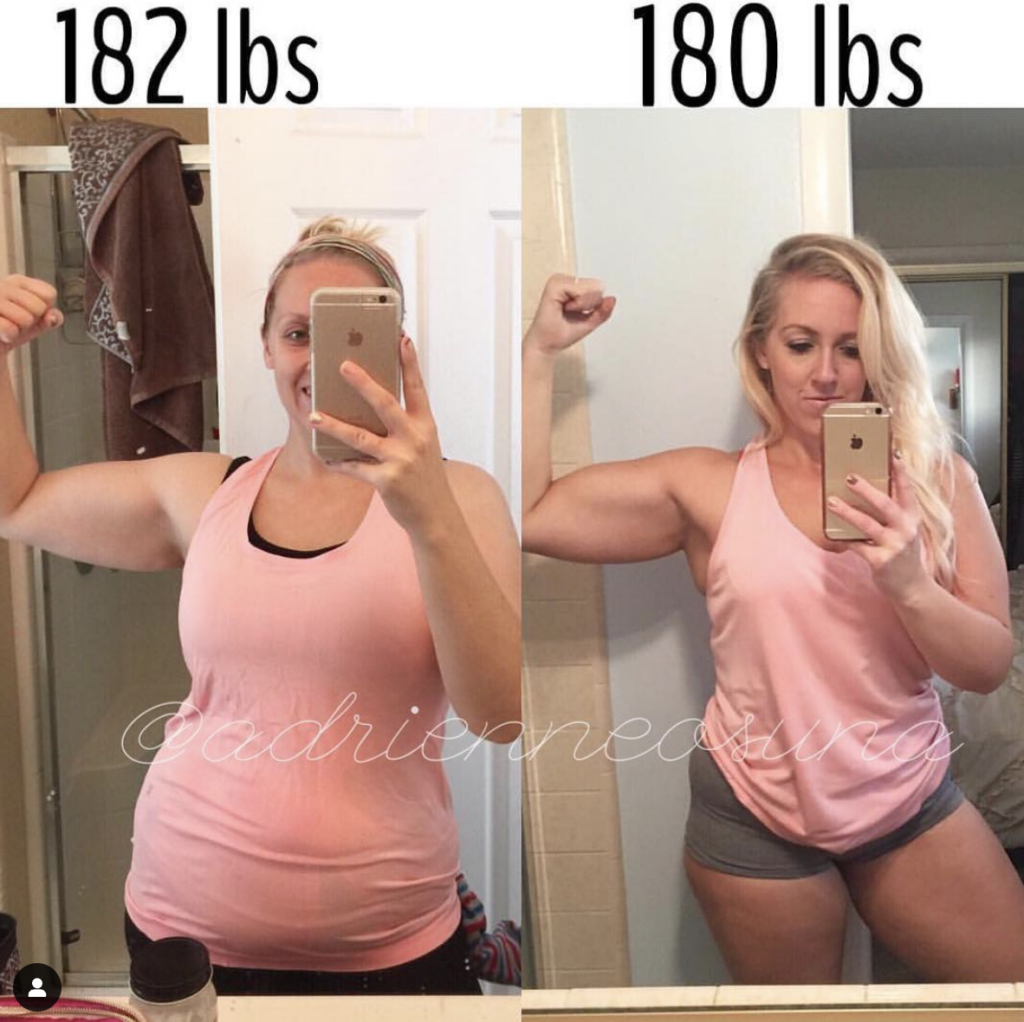
For years, Adrienne was a self-proclaimed “cardio bunny”. Despite the hours she spent doing aerobic exercise, she was continually battling with herself, both in achieving the physique she wanted and loving the body she had.
She needed a change and turned to weightlifting. She dropped her aerobic sessions to only two or three each week, and began strength training four days a week, as well as regularly practicing yoga. As her body began to visibly change – a rounder, firmer butt, a flatter stomach, and toned arms – she was shocked when she stepped on the scale. She had only lost two pounds!
She had lost fat, but gained muscle. Muscle tissue is much denser than fat tissue, so if you have a piece of muscle and a piece of fat that have the same size dimensions, the piece made of muscle will weigh more. When you begin exercising and change your diet, you will build muscle. The number on the scale does not reflect how much fat you are losing, only changes in total weight, which includes your newly-grown muscles.
Finally realizing how little her weight meant to her appearance and health, she ditched the scale and took to Instagram to share her new-found knowledge, in hopes that other women (and men!) can learn from her experience. Adrienne is now dedicated to spreading the message that the scale doesn’t tell the full story, stating that how you look and feel is more important than your total body weight. “Don’t obsess over the scale. You are focusing on your body building muscle and losing fat. The scale may not change!”
Adrienne is hoping to challenge women’s view on weightlifting and encourage them to step into the weight room with confidence. She wants to show women that strength training can help them achieve the physique they’ve always wanted, and learn to love their bodies in the process. “Will you be the only girl in there? Maybe. I often am. Does it matter? Nope,” she writes on her blog. “Everyone in there is there for the same reason. No one is better than anyone else, and everyone is willing to help.”
Why Does Muscle Weight More Than Fat?

Muscle and fat are both types of tissue, but they have different tissue densities. While fat has a density of about 0.9g/ml, muscle has a density of 1.06g/ml. All this means is that if you had a pound of fat and a pound of muscle, the fat would take up more space, because it’s not as “tightly packed” or dense as muscle tissue.
When we start making changes in our diet and exercise habits, we go through body re-composition, not just weight “loss”. While we burn fat, we’re also building up muscle- both processes are important. Here are 5 Health Benefits of Strength Training.
1/5 Benefits of Strength Training: Increased Metabolism
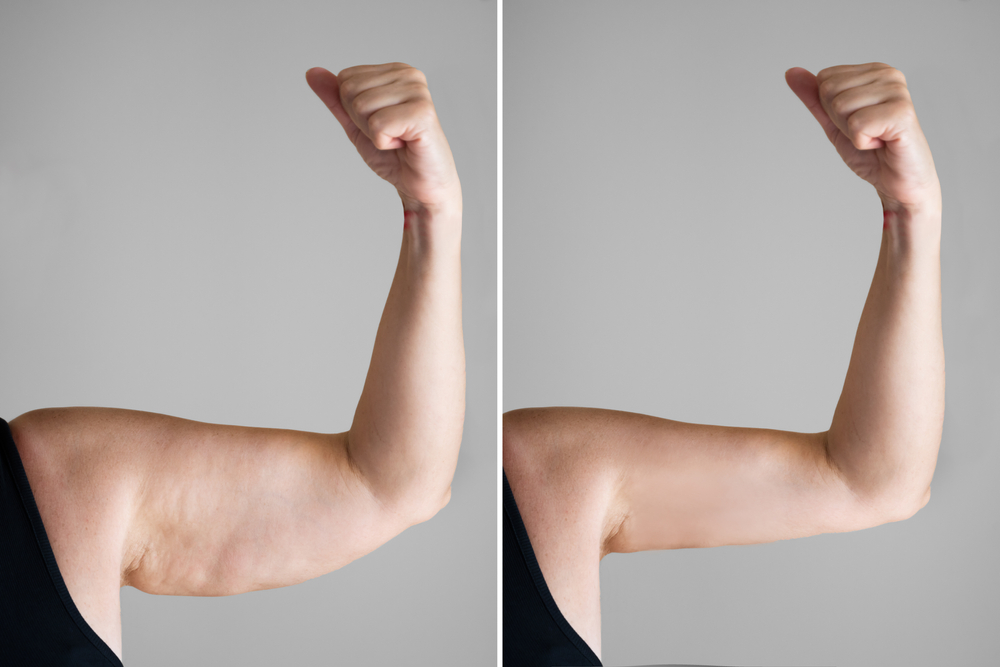
Muscle tissue is more metabolically active than fat tissue, which means that it burns more calories than fat does even when you aren’t working out. A faster metabolism means your body will convert the calories you eat into energy faster — storing less excess calories as fat. (1) (2)
2/5 Benefits of Strength Training: Prevents Diabetes

When you are lifting weights you are building muscle. That muscle has a much higher need for glucose than fat does, so it will scavenge it from your bloodstream. This lowers your blood sugar levels, which aids in the prevention and control of diabetes. (4) (5)(6)
3/5 Benefits of Strength Training: Improves Bone Density

Lifting weights puts stress on your bones just as it does on your muscles…but a good kind of stress! In the same way that ‘stressing’ your muscles makes them stronger, so does stressing your bones. Having stronger bones decreases your chance of developing osteoporosis, a degenerative bone disorder that occurs as you age, as well as protects against breaks and fractures from both chronic and acute damaging impact. (7)(8)
4/5 Benefits of Strength Training: Increases Coordination and Mobility

Weightlifting creates more muscle-to-brain connections, teaching controlled and coordinated movements. It also helps to maintain flexibility in your joints and ligaments. Maintaining a full range of motion is important in allowing you to easily do the everyday activities you need and want to, like making your bed, picking up your children or grandchildren, even just bending over to tie your shoe. (9)
Read More: Is Poor Liver Function Making You Gain Weight?
5/5 Benefits of Strength Training: Improves Longevity and Aging

Strength training has been shown to improve brain activity and keep your nervous system sharp, which can help fight back against age-related brain disorders such as Alzheimer’s and Dementia. It also helps ward off Sarcopenia, the loss of muscle mass associated with aging. This is a huge factor in stability, balance, and fall prevention in the elderly. (9)(10)(11)
As Adrienne has proven, the scale does not tell the whole story when it comes to weight loss and body satisfaction. Instead of focusing on the numbers, we need to switch our focus to getting stronger and healthier. Strength training will not only help you to lose weight and feel amazing, it will also teach you to love your body for what it can do, not just what it looks like. Here are Tips to Break Your Unhealthy Relationship with the Scale!
1. Create a weigh-in schedule
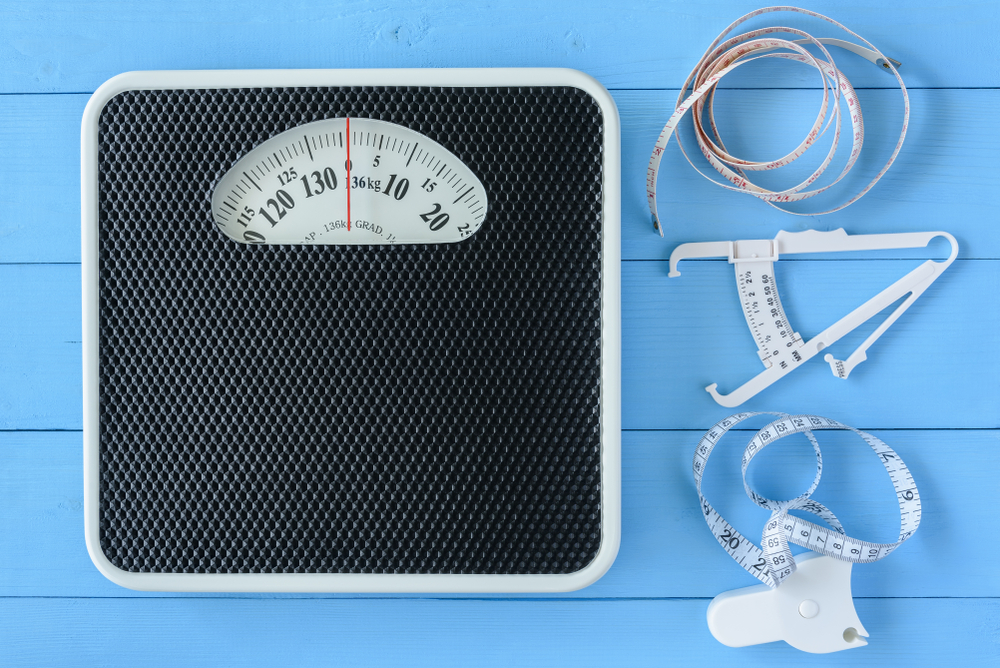
Pick the day and time you are going to weigh yourself each week (for example, every Tuesday morning right when you get up). Stick to that one time, and don’t step foot on the scale the rest of the week! Weighing yourself too frequently cultivates an unhealthy obsession with what the scale says.
2. Recognize Your Weight Changes ALL the Time
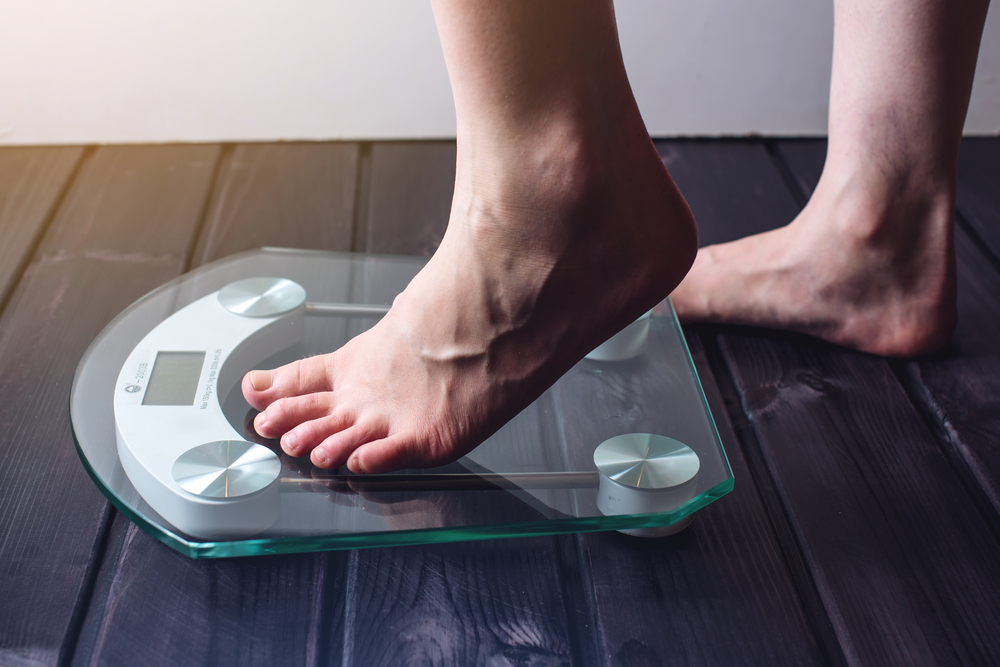
Between the time of day, whether you’ve just had a meal, or even where you are in your menstrual cycle, your weight fluctuates quite a bit all the time. You can lose or gain 5 pounds within just 24 hours! Your body is a complex machine- understanding its healthy cycles can help take the scale stress away.
3. Choose a Different Measurement
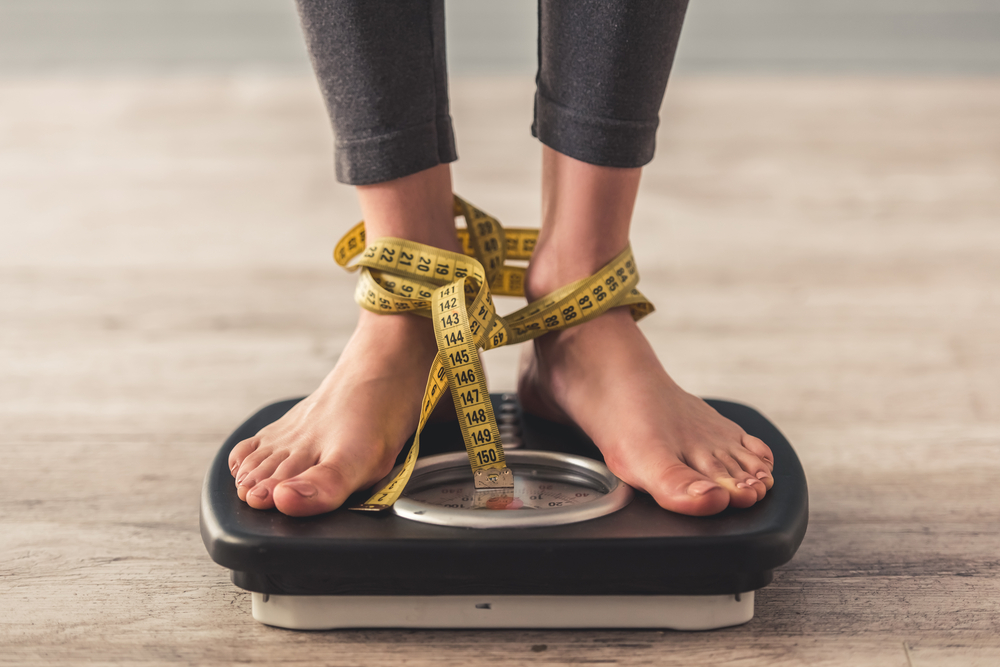
Whether you choose to keep track of your clothing size, compare monthly photoshoots, or even create a daily journal to keep track of how much energy and joie de vivre you have, there are so many alternative ways to measure your body change journey. It doesn’t have to be about the numbers at all!
Join us in the weight room and become your strongest, happiest self!
Read More: What’s Your Ideal Weight According To Your Height?
Sources
- (1) https://www.mayoclinic.org/healthy-lifestyle/weight-loss/in-depth/metabolism/art-20046508
- (2) https://www3.unip.br/comunicacao/publicacoes/ics/edicoes/2010/04_out-dez/V28_n4_2010_p337-340.pdf
- (4) https://www.jstage.jst.go.jp/article/endocrj/61/1/61_EJ13-0244/_article
- (5) https://www.diabetesincontrol.com/more-muscle-mass-knocks-out-insulin-resistance-and-prediabetes/
- (6) https://care.diabetesjournals.org/content/25/10/1729.short
- (7) https://www.ncbi.nlm.nih.gov/pubmed/9927006
- (8) https://link.springer.com/article/10.1007/s00198-015-3263-2
- (9) https://www.mayoclinic.org/healthy-lifestyle/fitness/in-depth/strength-training/art-20046670
- (10) https://www.sciencedirect.com/science/article/pii/S019745801100193X
- (11) https://cdnsciencepub.com/doi/abs/10.1139/H07-141#.WL7yYIvF8nM
